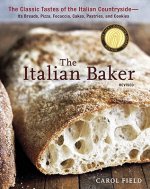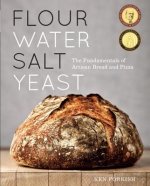
Kód: 06418284
Ice Cream
Autor Jeri Quinzio
"The discovery of a new dish does more for human happiness than the discovery of a star," the noted gourmet Brillat-Savarin once wrote. If that's so, the discovery of ice cream must be worth a whole galaxy. And the name of the dis ... celý popis
- Jazyk:
 Angličtina
Angličtina - Väzba: Brožovaná
- Počet strán: 110
Nakladateľ: Brick Tower Press, 2013
- Viac informácií o knihe

12.66 €
Bežne: 13.24 €
Ušetríte 0.58 €

Skladom u dodávateľa
Odosielame za 14 - 18 dní
Mohlo by sa vám tiež páčiť
-

Human Trafficking
22.47 € -

Jonathan Edwards On The Good Life
10.41 € -13 % -

It's Cool to Learn about Countries: Vietnam
40.04 € -

Úniky
9.80 € -18 % -

BURLINGTON ACTION 1§ESO WB BASIC PRACTICE 14 BURIN31ESO
22.26 €
Darujte túto knihu ešte dnes
- Objednajte knihu a vyberte Zaslať ako darček.
- Obratom obdržíte darovací poukaz na knihu, ktorý môžete ihneď odovzdať obdarovanému.
- Knihu zašleme na adresu obdarovaného, o nič sa nestaráte.
Viac informácií o knihe Ice Cream
Nákupom získate 31 bodov
 Anotácia knihy
Anotácia knihy
"The discovery of a new dish does more for human happiness than the discovery of a star," the noted gourmet Brillat-Savarin once wrote. If that's so, the discovery of ice cream must be worth a whole galaxy. And the name of the discoverer should be emblazoned in the heavens. The trouble is, we don't know who made that first dish of vanilla, strawberry or triple chocolate chunk ice cream. That may explain why there are candidates for the honor all over the world. Some give the ancient Romans credit for inventing ice cream, but although they did send their slaves off to the mountains to get snow, they didn't make ice cream with it. They poured syrup on it and ate it, or they used it to chill their wines or fruit. Others say Marco Polo brought ice cream back to Italy from China. He didn't. The Chinese and the Europeans developed their ice creams separately. In the Arab world, snow and ice were combined with fruits and a sweetener -- usually honey or sugar -- to make a chilled drink called a sharbât. The word led to the English sherbet, the French sorbet, the Italian sorbetto and the Spanish sorbete. But a sharbât was and still is a drink. The most-told story is that Catherine de Medici brought ices from Italy to France in the 16th century when she married the future king Henry II. The reality is that ices didn't appear in France for another century, and French confectioners said they had to go to Italy to learn how to make them. At the turn of the twenty-first century, Americans were eating 23 quarts of ice cream per person, per year, more than any other country. Vanilla was America's favorite flavor, with chocolate coming in second. The health issues associated with ice cream were no longer colic and cold stomachs; they were fat and cholesterol. Nevertheless, premium and super-premium ice cream sales were growing, and low-fat ice cream sales were shrinking. Manufacturers were researching the possibility of adding Omega-3 fatty acids to ice cream to give it the health benefits associated with salmon. With all the premium ice creams on the market today, why make your own? Because it's easy and it's fun. You don't need ice and salt for today's ice cream makers, and they're affordable and simple to use. You control the ingredients so you know exactly what's in your ice cream. No guar gum or salmon required. You can use your imagination, experiment with flavors and add your own chunky bits. You, like me, can make ice cream that's parfaite. Jeri Quinzio is a freelance writer and past president of the Culinary Historians of Boston. Jeri has contributed to the Radcliffe Culinary Times and Gastronomica.
 Parametre knihy
Parametre knihy
Zaradenie knihy Knihy po anglicky Lifestyle, sport & leisure Cookery / food & drink etc Cookery dishes & courses
12.66 €
- Celý názov: Ice Cream
- Podnázov: The Ultimate Cold Comfort
- Autor: Jeri Quinzio
- Jazyk:
 Angličtina
Angličtina - Väzba: Brožovaná
- Počet strán: 110
- EAN: 9781883283360
- ISBN: 9781883283360
- ID: 06418284
- Nakladateľ: Brick Tower Press
- Hmotnosť: 206 g
- Rozmery: 205 × 204 × 12 mm
- Dátum vydania: 31. October 2013
Obľúbené z iného súdka
-

Pierre Hermé Macaron
48.11 € -5 % -

Eclairs: Easy, Elegant and Modern Recipes
21.24 € -18 % -

Macarons
27.37 € -23 % -

Italian Baker, Revised
31.86 € -22 % -

Feast of Ice and Fire: The Official Game of Thrones Companion Cookbook
31.35 € -13 % -

Modern Sugar Flowers Volume 2
22.87 € -19 % -

Real Fast Curry Cookbook
16.95 € -

Vegan Cakes and Other Bakes
15.21 € -21 % -

Sugar Flowers: The Signature Collection
48.92 € -23 % -

Ciao Bella Book of Gelato and Sorbetto
20.83 € -20 % -

Perfect Cookie
30.02 € -17 % -

The Pizza Bible
31.15 € -

Flour Water Salt Yeast
31.66 € -12 % -

Baking Bible
42.90 € -

Artisan Sourdough Made Simple
19.50 € -23 % -

Elements of Pizza
25.43 € -18 % -

Wafer Paper Cakes
17.66 € -23 % -

Sourdough School
25.43 € -19 % -

Complete Magnolia Bakery Cookbook
21.14 € -5 % -

Bread Bible
37.99 € -7 % -

My Bread
33.09 € -

Tartine Bread
31.35 € -17 % -

Canapes
20.83 € -23 % -

Breakfast, The Cookbook
41.26 € -18 % -

Pie and Pastry Bible
50.76 € -

Elements of Dessert
76.10 € -

Great American Burger Book
22.77 € -21 % -

Buns and Burgers
25.02 € -4 % -

Baking
35.75 € -13 % -

Alan Dunn's Ultimate Collection of Cake Decorating
25.73 € -17 % -

Alan Dunn's Sugarcraft Flower Arranging
16.64 € -11 % -

All About Cake
32.17 € -9 % -

European Cake Cookbook
20.63 € -7 % -

Advanced Art of Pastry
74.97 € -6 % -

Modern Baking
32.37 € -14 % -

Patisserie at Home
53.62 € -

Prison Ramen
13.47 € -22 % -

Fine French Desserts
55.36 € -

Gelato Messina
22.87 € -

Quintessential Filipino Cooking
22.87 € -6 % -

Everybody Bakes Bread
9.08 € -3 % -

Magnolia Bakery Handbook
30.84 € -13 % -

Larousse Patisserie and Baking
47.39 € -22 % -

The Bread Baker's Apprentice
32.99 € -20 % -

Cheesecake Bible
22.67 € -13 % -

Nothing Fancy
30.74 € -9 % -

No Sugar Desserts and Baking Book
14.80 € -30 % -

Tartine
30.13 € -19 % -

Tarts
13.47 € -30 %
Osobný odber Bratislava a 2642 dalších
Copyright ©2008-24 najlacnejsie-knihy.sk Všetky práva vyhradenéSúkromieCookies


 21 miliónov titulov
21 miliónov titulov Vrátenie do mesiaca
Vrátenie do mesiaca 02/210 210 99 (8-15.30h)
02/210 210 99 (8-15.30h)